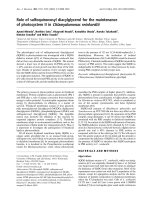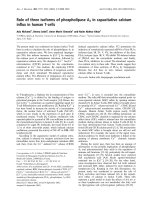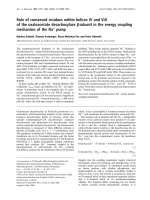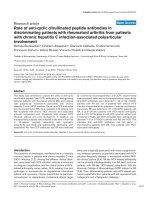Báo cáo y học: "Role of interleukin-7 in degenerative and inflammatory joint diseases" potx
Bạn đang xem bản rút gọn của tài liệu. Xem và tải ngay bản đầy đủ của tài liệu tại đây (42.44 KB, 2 trang )
Page 1 of 2
(page number not for citation purposes)
Available online />Abstract
IL-7 is known foremost for its immunostimulatory capacities,
including potent T cell-dependent catabolic effects on bone. In
joint diseases like rheumatoid arthritis and osteoarthritis, IL-7, via
immune activation, can induce joint destruction. Now it has been
demonstrated that increased IL-7 levels are produced by human
articular chondrocytes of older individuals and osteoarthritis
patients. IL-7 stimulates production of proteases by IL-7 receptor-
expressing chondrocytes and enhances cartilage matrix degrada-
tion. This indicates that IL-7, indirectly via immune activation, but
also by a direct action on cartilage, contributes to joint destruction
in rheumatic diseases.
IL-7 is well-known for its strong immunostimulatory proper-
ties, in particular for the role it has in T and B cell homeo-
stasis in mice and T cell homeostasis in humans. Less well-
studied is the role of IL-7 in (immuno)pathology, in particular
its role in joint diseases. In the previous issue of Arthritis
Research and Therapy, Long and colleagues [1] demonstrate
that IL-7 protein is produced by articular chondrocytes.
Production is increased upon stimulation with fibronectin
fragments and a combination of IL-1 and IL-6. Most interest-
ingly, endogenous production of IL-7 by cartilage tissue is
higher when obtained from older donors or from patients with
osteoarthritis (OA). Through chondrocyte-expressed IL-7
receptor (IL-7R), this IL-7 is demonstrated to induce produc-
tion of matrix metalloproteinase (MMP)-13 associated with
enhanced release of proteoglycans from cartilage matrix.
Thus, it has been suggested that IL-7 contributes in an auto-
crine manner to joint tissue destruction in OA and other joint
diseases.
In support of a role for IL-7 in OA, it was recently shown that
in synovial tissue of a substantial proportion of OA patients,
IL-7 is expressed at a significant level (albeit lower than in
rheumatoid arthritis patients) [2]. This IL-7 is considered to
contribute to cartilage destruction indirectly through activa-
tion of inflammatory cells that secrete catabolic cartilage-
destructive mediators, contributing to joint destruction. It has
now been suggested that IL-7 is involved in cartilage
destruction not only indirectly via inflammatory cells but also
directly via IL-7R-expressing chondrocytes. However, although
factors such as fibronectin fragment, and IL-1 and IL-6 induce
IL-7, the (patho)physiological triggers for IL-7 production by
human articular chondrocytes in vivo remain to be
determined. Mechanical stress is one of the mechanisms that
should be considered. Definitive proof should be provided by
blockade of the IL-7/IL-7R pathway, limiting intrinsic
degenerative cartilage destruction in vitro and in vivo,
preferably in experimental models of degenerative joint
damage that mimic OA but with minor inflammation [3]. This
is of particular importance since the amounts of IL-7
produced by chondrocytes in the experiments described by
Long and colleagues are below the amounts needed to
induce MMP-13 production and matrix degradation.
Irrespective of this, the data from the study of Long and
colleagues underline the role of IL-7 in the induction of joint
pathology in rheumatic diseases. It was recently demon-
strated that IL-7, apart from its role in T cell development in
humans, can stimulate inflammatory T cells to produce tissue
destructive cytokines that have a catabolic effect on cartilage
and bone [4-7]. Together these studies suggest that IL-7
promotes joint destruction especially in patients that suffer
from inflammatory (auto)immune diseases, many of which
have increased IL-7 levels. Thus it was demonstrated that IL-7
induced T cell-dependent activation of monocytes/macro-
phages is associated, amongst other things, with tumour
necrosis factor (TNF)α production [6]. Although it needs to
be demonstrated that this results in joint damage in RA, the
well-studied capacities of TNFα in this respect strongly
Editorial
Role of interleukin-7 in degenerative and inflammatory joint
diseases
Joel AG van Roon and Floris PJG Lafeber
Department of Rheumatology and Clinical Immunology, University Medical Center Utrecht, Heidelberglaan, 3584 CX Utrecht, The Netherlands
Corresponding author: Joel AG van Roon,
Published: 18 April 2008 Arthritis Research & Therapy 2008, 10:107 (doi:10.1186/ar2395)
This article is online at />© 2008 BioMed Central Ltd
See related research by Long et al., />IL = interleukin; IL-R = IL receptor; MMP = matrix metalloproteinase; OA = osteoarthritis; TNF = tumour necrosis factor.
Page 2 of 2
(page number not for citation purposes)
Arthritis Research & Therapy Vol 10 No 2 van Roon and Lafeber
suggest that this will be the case. TNFα is a potent inhibitor
of cartilage matrix synthesis and an inducer of cartilage
degradation (by activation of MMPs), processes that lead to
loss of cartilage integrity. TNFα also activates fibroblasts to
produce catabolic factors such as cytokines and MMPs that
indirectly facilitate cartilage destruction. IL-7 has also recently
been shown to induce T cell-dependent osteoclast formation
from monocytes. TNFα and RANKL (receptor activator of
nuclear factor kappa B ligand) are crucial mediators in this IL-
7-driven osteoclast formation [7]. Interestingly, in the study of
Long and colleagues, TNFα was not tested as an inducer of
chondrocyte produced IL-7, nor did IL-7 stimulation lead to
TNFα production by chondrocytes. This suggests that the
chondrocyte IL-7/IL-7R pathway is independent from and
additive with a TNFα-driven pathway. This is supported by
recent findings demonstrating TNFα-independent IL-7-driven
inflammatory and bone-destructive activity [6,7].
IL-7 is also able to regulate joint pathology by T cell-driven
immune activation in the absence of a clear inflammatory
response. Experimental data have recently demonstrated the
strong potential of IL-7 to facilitate bone loss. IL-7R-deficient
mice display increased bone volume and bone density [8]. In
contrast, IL-7-overexpressing transgenic mice are character-
ized by expanded bone marrow cavities with focal osteolysis
of cortical bone and eroded bone surfaces [9]. In addition,
estrogen deficient mice (induced by ovariectomy) are
characterized by increased IL-7-driven T cell-dependent bone
loss [10].
By giving a first glimpse of the direct effects of IL-7 on
chondrocytes, the study of Long and colleagues contributes
to our knowledge on the broad range of IL-7/IL-7R-driven
pathways. In addition to its role in inflammation driven joint
destruction, and its potential role in T cell-driven bone loss in
the absence of prominent inflammation, direct harmful effects
on cartilage can be added to the list of catabolic properties of
IL-7. In this respect, the IL-7/IL-7R-stimulated pathology is a
target of interest for the treatment of rheumatic diseases such
as rheumatoid arthritis, osteoporosis and OA.
Competing interests
The authors declare that they have no competing interests.
References
1. Long DL, Blake S, Song XY, Lark M, Loeser RF: Human articular
chondrocytes produce IL-7 and respond to IL-7 with
increased production of matrix metalloproteinase-13. Arthritis
Res Ther 2008, 10:R23.
2. Hartgring SA, Wenting MJ, Jacobs KM, Bijlsma JW, Lafeber FP,
van Roon JA: IL-7-induced immune activation due to elevated
expression of the IL-7 receptor in RA joints can be inhibited by
soluble human IL-7 receptor. Arthritis Rheum 2007, 56:1991.
3. Marijnissen AC, van Roermund PM, TeKoppele JM, Bijlsma JW,
Lafeber FP: The canine ‘groove’ model, compared with the
ACLT model of osteoarthritis. Osteoarthritis Cartilage 2002, 10:
145-155.
4. Hartgring SA, Bijlsma JW, Lafeber FP, van Roon JA: Interleukin-7
induced immunopathology in arthritis. Ann Rheum Dis 2006,
65(Suppl 3):iii69-iii74.
5. van Roon JA, Verweij MC, Wijk MW, Jacobs KM, Bijlsma JW,
Lafeber FP: Increased intraarticular interleukin-7 in rheuma-
toid arthritis patients stimulates cell contact-dependent acti-
vation of CD4(+) T cells and macrophages. Arthritis Rheum
2005, 52:1700-1710
6. van Roon JA, Hartgring SA, Wenting-van Wijk M, Jacobs KM, Tak
PP, Bijlsma JW, Lafeber FP: Persistence of IL-7 activity and IL-7
levels upon TNF
αα
blockade in patients with rheumatoid arthri-
tis. Ann Rheum Dis 2007, 66:664-669.
7. Weitzmann MN, Cenci S, Rifas L, Brown C, Pacifici R: Inter-
leukin-7 stimulates osteoclast formation by up-regulating the
T-cell production of soluble osteoclastogenic cytokines. Blood
2000, 96:1873-1878.
8. Miyaura C, Onoe Y, Inada M, Maki K, Ikuta K, Ito M, Suda T:
Increased B-lymphopoiesis by interleukin 7 induces bone
loss in mice with intact ovarian function: similarity to estrogen
deficiency. Proc Natl Acad Sci USA 1997, 94:9360-9365.
9. Valenzona HO, Pointer R, Ceredig R, Osmond DG: Prelym-
phomatous B cell hyperplasia in the bone marrow of inter-
leukin-7 transgenic mice: precursor B cell dynamics,
microenvironmental organization and osteolysis. Exp Hematol
1996, 24:1521-1529.
10. Weitzmann MN, Pacifici R: Estrogen deficiency and bone loss:
an inflammatory tale. J Clin Invest 2006, 116:1186-1194.









